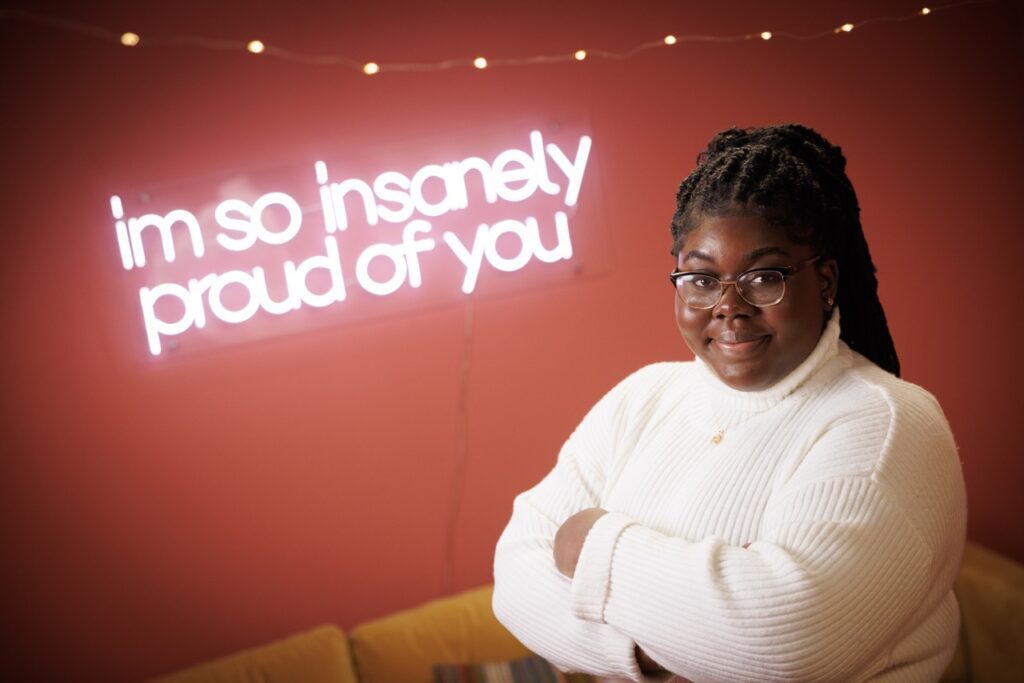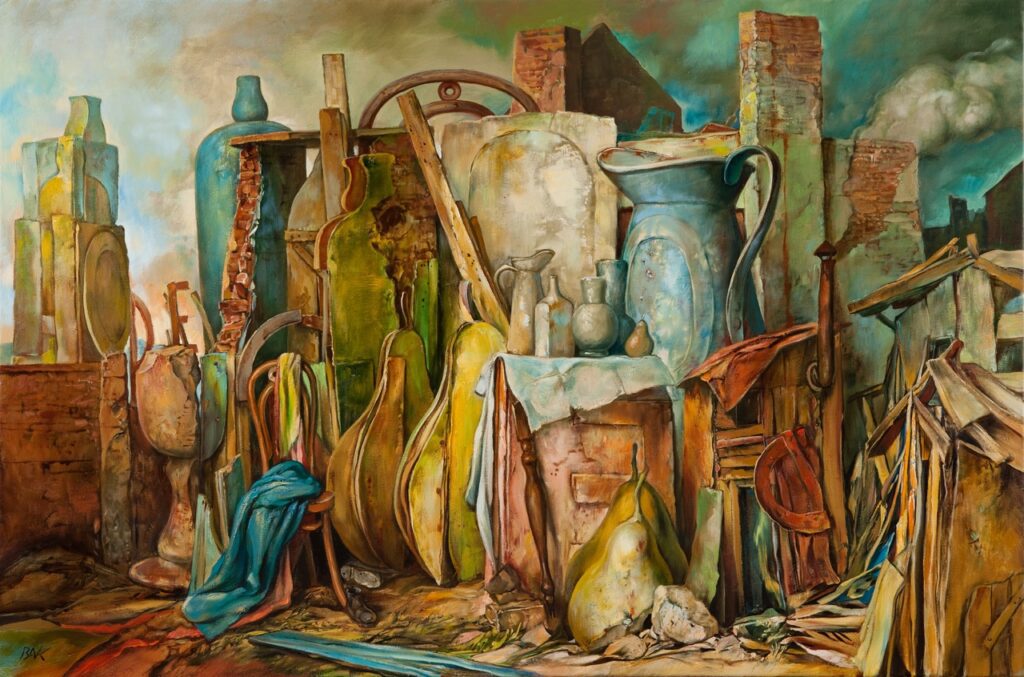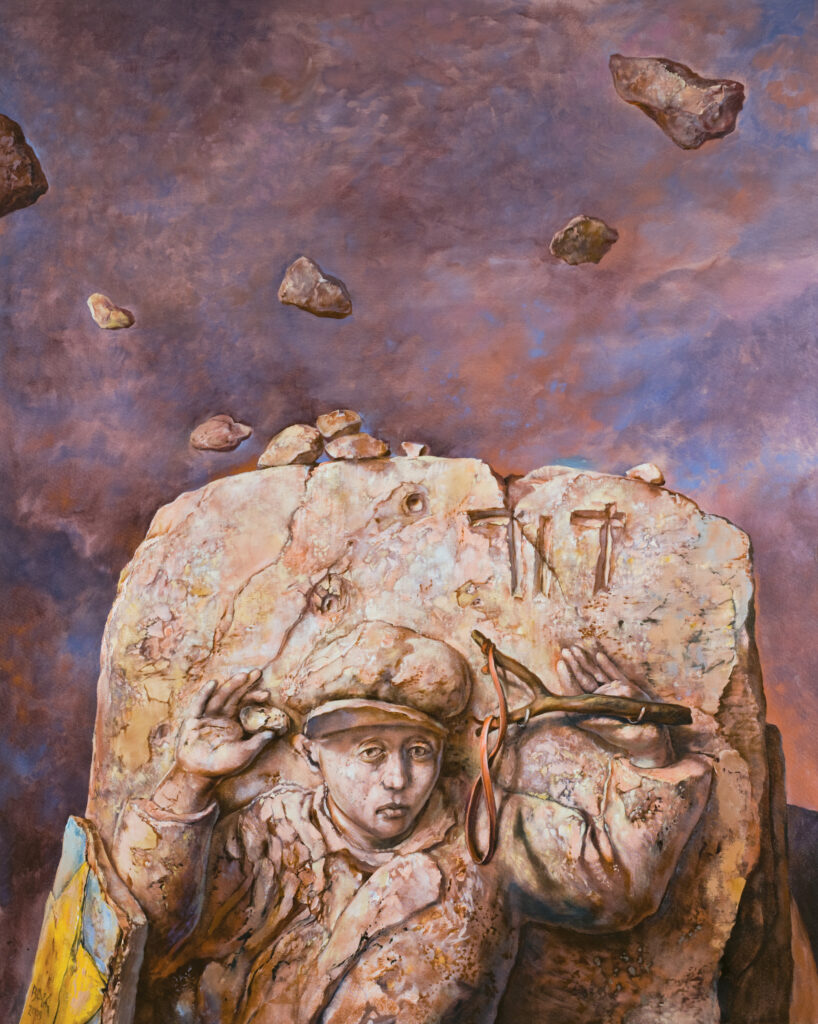Students Go Live in State-of-the-art Experience Lab
By Deborah Shanahan
On a March Friday night, with spring football curiosity running high, University of Nebraska–Lincoln Athletic Director Trev Alberts sat for a live interview on the new set of Nebraska Nightly, a student-led newscast.
It was quite a score for Nathan Hawkins, a senior from Bellevue, Nebraska. The sports media and communication and broadcasting major said he had prepared all week for the exclusive interview.
Afterward, Alberts told an interviewer that he was impressed by the investment the university has made to give journalism students the tools they need to develop their skills.
“People should know the technology here is amazing,” Alberts said. “There’s a lot of talent in the room, you can tell. A lot of passion.”
Passion is a word several students also used to describe what they’re drawing from the College of Journalism and Mass Communications’ heavy emphasis on experiential learning, along with practice, portfolios and professional contacts.
“I’m jealous of freshmen who will have this their entire careers here,” said Lance Vie, a senior broadcasting major from Fontanelle, Nebraska. “Look around at this nice new studio. Students sit in front of the equipment and their eyes light up. It’s all stuff they want to learn.”
Journalism colleges long have strived to offer real-world experiences, but usually after a year or two of basic skills learning. At UNL, under the leadership of the College of Journalism and Mass Communications Dean Shari Veil, MBA, Ph.D., the college’s motto is “do from day one.” Beginning this year, freshmen are required to enroll in an Experience Lab course their first semester on campus.
“Practice makes perfect, and we’re all practice all the time,” said Jemalyn Griffin, co-director of the Experience Lab.
The interdisciplinary lab breaks down barriers and silos, Griffin said, giving students a broad sense of different areas of opportunity. “We hope to respond to what the market is demanding,” she said.
The early access to hands-on experiences is already boosting enrollment. Veil wrote in December that the college’s 16.3% growth in incoming freshmen led the university, and transfer enrollments more than doubled.
A hub of this hands-on learning is the Don and Lorena Meier Studio, which opened in November in Andersen Hall. The foundation established by the couple pledged $10 million for scholarships over the next 25 years and $755,000 for the new television studio and newsroom.
The Meiers were familiar with quality broadcasting through their own media careers, which included producing the well-known “Mutual of Omaha’s Wild Kingdom.” Don Meier, who died in 2019, wanted to assist students because he recalled his own struggles to afford college.
The investments have continued, Veil recently told donors in a letter, citing the Phil Perry Family Photography Studio and Classroom, a new radio tower and antenna on Oldfather Hall, the new Pepsi Unlimited Sports Lab and more sponsors for student-run advertising agencies.
The Pepsi Unlimited Sports Lab serves the fast-growing sports media and communication major, which was established in 2017 and enrolled 300 students as of last fall. The space features state-of-the-art equipment, which allows students to go live during sports broadcasts.
Advertising and public relations majors mostly work across the street from the studio at what’s known as The Agency — 14 offices customized and furnished by sponsoring firms.
In all, the Experience Lab spaces house Unlimited Sports; Jacht, a student-run advertising agency; Buoy, an advertising and public relations agency for nonprofits; KRNU, the campus radio station; Heartland Pulse, an online community magazine; the Nebraska News Service, a statewide wire service; and Nebraska Nightly, a recorded news show.
Students working in the Meier studio spaces and newsroom have provided coverage of election night, the Nebraska Legislature and other news, feeding the Nebraska News Service.
“Over and over, we see weeklies pick up our content,” said Jill Martin, co-director of the Experience Lab. A Panhandle newspaper usually is not going to have the staff to send to Lincoln for a legislative hearing, she said, so it’s truly a service when students provide the coverage.
Students work four to six hours a week in the lab. From their work, students build portfolios to show potential employers.
“Young professionals I’ve spoken to are blown away by the opportunity we get right from the day we start college,” said Paige Brophy, a junior advertising and public relations major from Lincoln. “We’re exposed to real-life work for real-life clients. Our ideas are implemented in the real world.”
Students praise the chances they get to work with industry professionals and to take on leadership roles themselves because of the Experience Lab’s human infrastructure.
Volunteer professionals-in-residence and paid student leads help to coach students from idea to production, providing technical know-how, guidance and feedback.
Odelia Amenyah, a senior from Omaha majoring in advertising and public relations and journalism, said she works with fellow students on interviews and gathering other components of content packages. The Experience Lab is a great setup for when students want to team up, she said.
The student lead role is not just about production, Martin said.
“We talk a lot about cultivating leadership, managing up and down, communication and collaboration,” she said.
The professionals-in-residence share best industry practices and get a chance to observe and interact with students for their own recruiting.
Kloee Sander, a senior from Lincoln, said her college connections led to several off-campus work experiences, including several months at a local television station. She was exposed to the behind-the-scenes work of getting an investigative report on the air. Now, she is headed to law school after she graduates in May.
“I saw the impact a lawyer can have on newsroom storytelling,” she said.
For sports broadcasting major Hawkins, watching students create something they are proud of has been one of his favorite parts of working in the lab. But nothing beats the assignment today.
“Overall, the best part is doing what I’m doing today,” Hawkins said. “The Alberts interview.”


“For me, it’s been a really great place to communicate with different faculty, to build relationships with them. That’s led to different opportunities. It’s helped with my portfolio, and I’ve had a chance to show management skills.”







